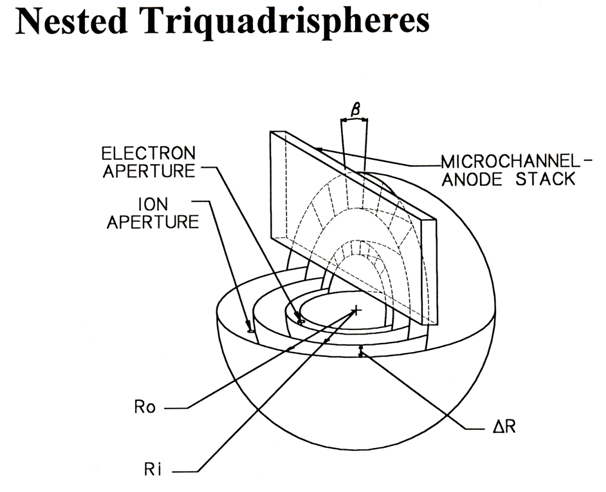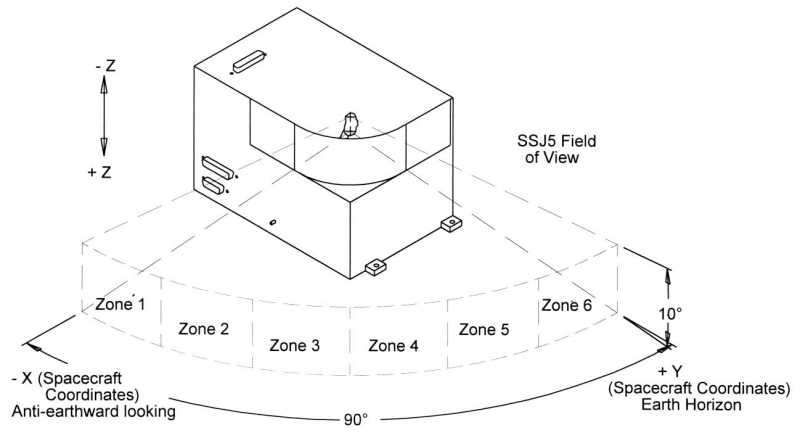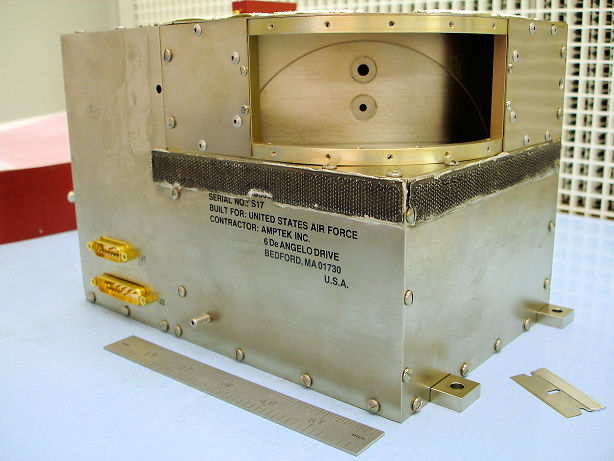
The SSJ5 instrument consists of a pair of nested triquadrispherical (270°) electrostatic analyzers as shown in the figure below. It is designed to provide data on the characteristics of precipitating auroral particles, which are a major source of energy for the ionosphere. Triquadrispherical electrostatic analyzers had been used previously in the CRRES low energy plasma analyzer and in the TSS-1/SPREE space shuttle experiment.

Once per second, the SSJ5 measures electrons and ions over an energy range from 30KeV to 30eV in nineteen logarithmically spaced steps. The field of view is a 4º by 90º fan for electrons and ions ranging from zenith to the horizon. The 90º field of view is divided into six 15º zones or sectors (as shown in Figure below). The SSJ5 has the capability of providing particle pitch angle by comparison of the six zones once per second.

Within the DMSP program the SSJ5 is required to continue providing the established functionality of its predecessor, the SSJ4. Within this program the main function of the instrument is to identify auroral boundary crossings. In contrast with the SSJ5, the SSJ4 has cylindrical electrostatic analyzers, a much smaller zenith-oriented field of view (2° by 5° for the 30 keV to 1 keV channels and 4° by 5° for the 1 keV to 30 eV channels) , and cannot provide pitch angle. The SSJ5 has inherited the restricted-bandwidth telemetry of the SSJ4. This telemetry in turn restricts the amount of SSJ5 data that can be retrieved from the DMSP spacecraft (one sixth of the data actually generated by the SSJ5 instrument). The SSJ5 CPU acquires sensor data from the accumulators and log-compresses the counts in a format that is compatible with the SSJ4. The spacecraft then telemeters the data and instrument status information to the ground.
To comply with the restricted telemetry bandwidth, the SSJ5's PROM is currently configured to provide data in either of two modes. In Mode A, electron and ion counts from all six zones are summed once per second. The output of Mode A is similar to the SSJ4 output except for the differing field of view, and provides no pitch angle resolution. In Mode B, the instrument cycles through the six zones. Each second the sum of electron and ion counts from the most recent six samples (one sample per second) is provided for one zone. The SSJ5 completes a sweep of all six zones once every six seconds. Mode B does provide pitch angle information, however the six-second (roughly 40 km) resolution of mode B is less than the inherent one-second resolution of the SSJ5. In addition the six zones are not sampled simultaneously. Both of these limitations of mode B are due to spacecraft telemetry limitations. Although it is anticipated that the SSJ5 will be operated primarily in mode A, several weeks of mode B data obtained during early orbit testing ( for F16: from ~1900 U. T. on Jan 16, 2004 to ~1900 U. T. on March 3, 2004) can provide information on the distribution of particle pitch angles, potentially useful for the design of future products or for calibration/validation of other instruments.
The SSJ5 uses its 270° spherical deflection system to discriminate ions and electrons from 30 eV through 30 KeV. Microchannel plates are then used to amplify and transform single ion or electron events into charge pulses that may be counted. The SSJ5 uses the spacecraft bus voltage of 28 volts DC and the data interface to time and transfer energy/count rate results.
The normal data rate is 1 full energy sweep per second (50 msec accumulation time for each of the 19 energy steps, and a 50 msec flyback interval) that is summarized into 360 bits per second. These 360 bits are divided into forty 9-bit words; 19 logarithmically spaced energy measurements for electrons and ions, and two 9-bit words used for status. Each data word is log compressed using a four-bit exponent and a five-bit mantissa. This scheme allows count rates from zero (a telemetered value of 1) to 2,064,351 (a telemetered value of 255) to be contained in 9 bits. A telemetered value of zero indicates that the instrument is off. Because there is one less energy channel for SSJ5 and for SSJ4, the data space for the used channel is used for house-keeping data.
Fully assembled, the SSJ5 dimensions are 6.0" high by 5.75" wide by 8.75" long and weighs 7.0 lbs. The photo below shows the SSJ5 S/N 17 instrument fully assembled and ready to be mounted on a DMSP spacecraft. The red arming plug on top will be replace with a gold plug just before launch.

References:
1. Oberhardt, M. R., D. A. Hardy, W. E. Slutter, J.
O. McGarity, D. J. Sperry, A. W. Everest, A. C. Huber, J. A. Pantazis and M. Pl
Gough, The shuttle potential and return electron experiment (SPREE), IL
Nuovo Cimento, Vol. 17, N. 1, p 67, Gennaio-Febbraio, 1994.